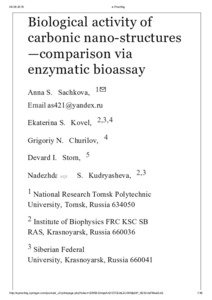BIOLOGICAL ACTIVITY OF CARBONIC NANO-STRUCTURES-COMPARISON VIA ENZYMATIC BIOASSAY
Скачать файл:
URI (для ссылок/цитирований):
https://link.springer.com/article/10.1007/s11368-018-2134-9https://elib.sfu-kras.ru/handle/2311/142833
Автор:
Sachkova, A. S.
Kovel, E. S.
Kudryasheva, N. S.
Churilov, G. N.
Stom, D. I.
Коллективный автор:
Институт инженерной физики и радиоэлектроники
Базовая кафедра физики твердого тела и нанотехнологий
Дата:
2019-06Журнал:
Journal of Soils and SedimentsКвартиль журнала в Scopus:
Q1Квартиль журнала в Web of Science:
Q2Библиографическое описание:
Sachkova, A. S. BIOLOGICAL ACTIVITY OF CARBONIC NANO-STRUCTURES-COMPARISON VIA ENZYMATIC BIOASSAY [Текст] / A. S. Sachkova, E. S. Kovel, N. S. Kudryasheva, G. N. Churilov, D. I. Stom // Journal of Soils and Sediments. — 2019. — Т. 19 (№ 6). — С. 2689-2696Аннотация:
Purpose: The aim of the work is to compare the biological activity of carbonic nano-structures of natural and artificial origination, namely, humic substances (HS) and fullerenols. Materials and methods: The representative of the fullerenol group, С 60 О y (OH) x where у + x = 20–22, was chosen. Enzyme-based luminescent bioassay was applied to evaluate toxicity and antioxidant properties of HS and fullerenol (F); chemiluminescent luminol method was used to study a content of reactive oxygen species (ROS) in the solutions. Toxicity of the bioactive compounds was evaluated using effective concentrations ЕС 50 ; detoxification coefficients D OxT were applied to study and compare antioxidant activity of the compounds. Antioxidant activity and ranges of active concentrations of the bioactive compounds were determined in model solutions of organic and inorganic oxidizers—1,4-benzoquinone and potassium ferricianide. Results and discussion: Values of ЕС 50 revealed higher toxicity of HS than F (0.005 and 0.108 g L −1 , respectively); detoxifying concentrations of F were found to be lower. Antioxidant ability of HS was demonstrated to be time-dependent; the 50-min preliminary incubation in oxidizer solutions was suggested as optimal for the detoxification procedure. On the contrary, F’ antioxidant effect demonstrated independency on time. Antioxidant effect of HS did not depend on amphiphilic characteristics of the media (values of D OxT were 1.3 in the solutions of organic and inorganic oxidizers), while this of F was found to depend: it was maximal (D OxT = 2.0) in solutions of organic oxidizer, 1,4-benzoquinone. Conclusions: Both HS and F demonstrated toxicity and low-concentration antioxidant ability; however, quantitative characteristics of their effects were different. The differences were explained with HS polyfunctionality, higher ability to decrease ROS content, non-rigidity, and diffusion restrictions in their solutions. Antioxidant effect of the bioactive compounds was presumably attributed to catalytic redox activity of their π-fragments. The paper demonstrates a high potential of luminescent enzymatic bioassay to study biological activity of nano-structures of natural and artificial origination.

